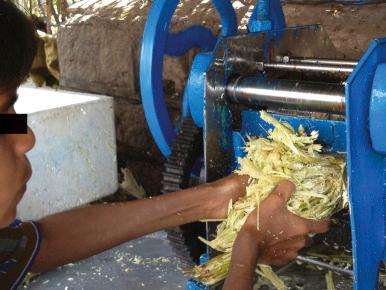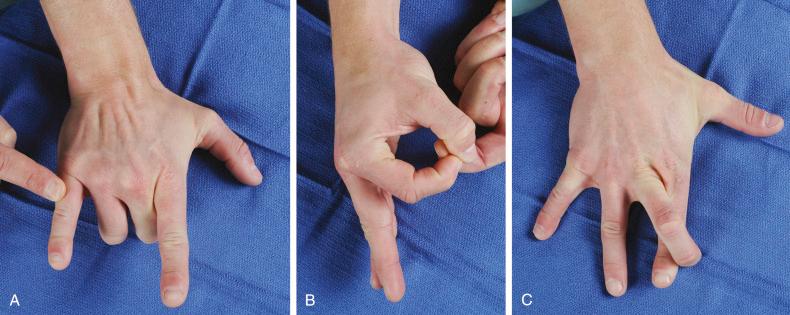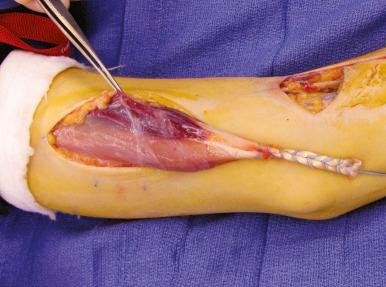Physical Address
304 North Cardinal St.
Dorchester Center, MA 02124
The following videos are included with this chapter and may be viewed at ExpertConsult:
Video 8.1 Tinel sign.
Video 8.2 Desensitization.
Video 8.3 Follow-up clinical examination.
Nerve injuries in children are relatively uncommon; however, children tend to put their hands in all sorts of unexpected places with sharp objects. Garbage disposals, conveyer belts, and dishwashers are uninteresting to adults but are a fascinating source of curiosity for children ( Fig. 8.1 ). Reaching into a nest of sharp surfaces can lead to varying degrees of damage to the pediatric hand, including nerve injury. In emerging countries, childhood labor is common and occupational safety is lacking, which leads to dangerous conditions ( Fig. 8.2 ). In addition, the advent of high-velocity sporting events like the X Games has resulted in an increasing incidence of severe, high-energy fractures in children, with periosteal disruption and marked fracture displacement. The surrounding nerve(s) are in jeopardy from sharp, bony fragments unchecked by the normal encompassing periosteum. Even if the nerves are not lacerated from the fracture fragments, traction on the nerves and swelling may result in nerve injury and compartment syndrome. Lastly, although iatrogenic nerve injuries are uncommon, surgeons unfamiliar with the idiosyncrasies of the pediatric musculoskeletal system can make the operating room a less safe place for children. Regardless of the cause, iatrogenic nerve injuries are distressing to the physician, child, and family. This chapter will discuss the prevention, diagnosis, and treatment of upper extremity nerve injuries in children.


Infants, young children, teenagers, and adolescents are not only distinctly different than adults in their ability to provide an accurate history and comply with a thorough examination, but are also distinctly different from each other. Infants cannot provide a history at all, and young children are notoriously poor historians. Teenagers have a difficult time expressing their symptoms, expectations, and concerns, whereas adolescents tend to perseverate on factors that may be peripheral to the central problem. Parents are often unclear about the onset of symptoms or the severity of the injury, and family dynamics can introduce stress and frustration for both the child and the physician. The musculoskeletal and neurovascular evaluation, made difficult by the suboptimal available history, is further complicated by an often-limited examination. One cannot approach an infant or young child and expect to have them sit still and cooperate with an examination. The examination of young children is relegated to playtime and requires gentle encouragement. The authors’ office is replete with age-appropriate toys that allow the surgeon and occupational therapists to interact and observe the child in a less threatening environment. The authors spend a lot of time observing patterns of hand usage, looking for clues that signal potential nerve injuries.
The sensory examination in children is fraught with error. Children are unable to reliably participate in two-point discriminatory assessment until about 8 years of age. Any attempt at pinprick examination will quickly end the examination. A subtler and less invasive test is to evaluate for moistness or dryness of the fingers compared with the unaffected hand. Fingers without sensory innervation will be dry compared with uninjured digits. Another test is submersing the hand in warm water and checking for pruning of the digits, which also requires innervation. However, the classic sign of a sensory nerve injury in children is neglect of the insensate digit(s). In other words, a 3-year-old who has injured his median nerve will revert to an ulnar grasp pattern with his ring and small fingers, avoiding the thumb, index, and long fingers in pinch and grasp. The sine qua non finding of reinnervation is similar because hypersensitivity during nerve regeneration is painful, again leading to avoidance. The authors have seen children with such intense hypersensitivity during nerve recovery that they avoid washing or cutting their nails on that part of the hand.
The motor examination can also be frustrating to the examiner and the child, particularly if the child is tired, hungry, teething, or ill. The examination should initially gain the confidence and trust of the child and the parents. The child must be comfortable with the physician being in the room before the physician can place hands on the child for an examination. Subsequently, the examination should be succinct with a focus on determination of the motor status of the nerve(s) in question. The examiner should begin with the most important and least painful or disruptive tests, reserving anything that requires restraining the child or causing the child discomfort for last. A slow, deliberate, and detailed examination is impractical in the infant and child. A comprehensive knowledge of the anatomy of the peripheral nervous system is critical for facilitating an accurate and swift diagnosis. From a practical standpoint, the authors assess peripheral nerves according to Table 8.1 and Fig. 8.3 . Adolescents can be examined in a manner similar to adults, both for motor and sensory determination.
| Nerve | Assessment | Favorite Test (Age Dependent) |
|---|---|---|
| Radial | Wrist extension Digital extension (metacarpophalangeal joint) Elbow extension | “Hook em horns” “Thumbs up” |
| Median | Thumb and index finger distal interphalangeal joint flexion (anterior interosseous nerve) Flexor digitorum superficialis via proximal interphalangeal joint flexion Thumb palmar abduction Forearm pronation | OK sign Thumbpalmarabduction |
| Ulnar | Digital abduction and adduction ring and small distal interphalangeal joint flexion | Cross fingers |
| Musculocutaneous | Elbow flexion | “Make a muscle” |
| Axillary | Shoulder-forward flexion and abduction | “Reach for the sky” |

Nerve conduction, the nerve’s primary function, can be compromised by ischemia or necrosis, distraction or stretch injuries, and laceration. Ischemia is, by definition, reversible, whereas necrosis is not. Early or mild ischemia can lead to focal demyelination, with characteristic slowing of nerve conduction across the lesion on electrodiagnostic studies. Prolonged ischemia can result in a complete conduction block, but the nerve distal and proximal to the lesion typically has normal conduction. Severe compression, devascularization, or tenting of a nerve over a bony prominence or hardware can eventually lead to nerve necrosis. The necrotic nerve becomes “woody,” with localized fibrosis in the necrotic segment. Distally, the axons degenerate (Wallerian degeneration), but the neural architecture remains intact. Spontaneous neurologic recovery is limited because the fibrotic scar blocks axonal sprouting.
Lacerations can be complete or incomplete. Partial lacerations can partly recover spontaneously if the distal and proximal lacerated segments continue to line up with each other. Imperfect coaptation or gapping can lead to the formation of a neuroma-in-continuity. Complete lacerations have poor potential for spontaneous recovery. Traction injuries can similarly show a variable degree of recovery potential based on the amount of disruption of the axons and the supporting neural architecture.
The severity of a traumatic nerve injury begins with neuropraxia, extends to axonotmesis, and concludes in neurotmesis. Neuropraxia is a segmental demyelination with maintenance of intact nerve fibers and the axonal sheath. A temporary localized conduction block follows, without axonal damage or Wallerian degeneration. Nerve conduction in the segments proximal to or distal to the site of demyelination is unaffected. Complete recovery follows over the subsequent days to weeks as remyelination is completed. Electrodiagnostic studies demonstrate either a decrease in nerve conduction velocity or a complete conduction block across the area of demyelination, but no electromyographic (EMG) changes of denervation are seen within the muscle. Conduction velocities and amplitudes across nerve segments outside of the zone of injury are usually normal.
Axonotmesis is a disruption of nerve fiber integrity with conservation of the architecture of the axonal sheath. Wallerian degeneration and subsequent nerve fiber regeneration are necessary for recovery. Retrograde degeneration is limited to the next more proximal node of Ranvier. Distal antegrade degeneration continues down the entire length of the nerve to the motor end plate. The cell bodies (dorsal root ganglion and anterior horn cells) switch from regulatory bodies to renewal centers. Axonal sprouting into the retained axonal sheath and framework occurs at a slow rate of 1 mm/day, or approximately 1 inch/month, but may be faster in younger children and infants. Electrodiagnostic studies exhibit loss of nerve conduction distal to the lesion and EMG changes of muscle denervation (i.e., insertional activity, fibrillations, and positive sharp waves). Partial axonotmetric injuries where part of the nerve is intact or just demyelinated will show a normal conduction velocity distal to the lesion but a decrease in amplitude relative to the degree of axonal loss. Prolonged denervation (>18–24 months) results in irreversible motor end-plate degradation with fatty degeneration and fibrosis of the target muscle ( Fig. 8.4 ). In contrast, the encapsulated sensory receptors retain their capacity for reinnervation for many years. Considering all these factors, the outcome after axonotmesis is variable. Distal injuries closer to the end plates recover better than proximal injuries. Sensory recovery is also possible long after the possibility of motor recovery has passed. This information regarding recovery should be conveyed to the patient and family.

Neurotmesis is an interruption of the nerve fiber and axonal sheath. Transection is the common example of this injury, but severe traction or contusion can produce similar disruption of nerve integrity. The prognosis is bleak without surgical intervention. Nerve repair or reconstruction is necessary to restore axonal inflow to the downstream muscles and sensory receptors. After restoration of nerve continuity, the same process ignites as described for axonotmesis. In other words, axonal sprouting into the retained axonal sheath and framework occurs at a slow rate of 1 mm/day or 1 inch/month. Electrodiagnostic studies cannot distinguish between a neurotmetric and an axonotmetric injury. Imaging studies that are currently available are likewise of little help. Unfortunately, the only way to distinguish between these two injury types is to observe for spontaneous recovery. An axonometric injury will exhibit an advancing Tinel sign and recovery of the muscle most proximal to the nerve injury.
Peripheral nerve imaging is still in its infancy. Magnetic resonance neurography and its related techniques for imaging neural tracts in the brain and spinal cord (tractography or diffusion tensor imaging) are still under development for imaging nerve continuity. Ultrasound is also undergoing technical modifications and software updates for improved nerve imaging. Currently, these imaging studies are unable to accurately discriminate an axonotmesis from a neurotmesis unless there is a clear gap between the nerve ends.
Electrodiagnostic studies also have a limited role in the treatment algorithm of children with peripheral nerve injuries. EMG can discriminate neuropraxia from axonotmesis or neurotmesis. Because neuropraxia represents segmental demyelination with preservation of intact axons, EMG results will remain normal except for decreased recruitment. In contrast, axonotmesis and neurotmesis interrupt axonal integrity and lead to fibrillation potentials in the affected muscles. One potential benefit of EMG is the ability to detect reinnervation before it is evident on clinical examination, which allows an earlier diagnosis of axonotmesis. Reinnervation findings include active polyphasic motor units, the emergence of nascent potentials, and a decrease in the number of fibrillation potentials. However, the lack of early detection of reinnervation on EMG does not exclude the possibility of later recovery and does not definitively diagnose neurotmesis. In other words, the presence of reinnervation makes everyone feel better sooner, but its absence does not guide treatment.
The treatment algorithm of nerve injuries may seem overwhelming to those physicians unaccustomed to managing nerve problems. The basic tenets guiding all treatment decisions are based on the slow rate of nerve regeneration (1 mm/day) and the need to save the motor end plate from irreversible end-plate demise 18 to 24 months after an injury. The hardest part of the algorithm is discriminating axonotmesis from neurotmesis. Currently, no available electrodiagnostic or imaging test can accurately distinguish between the two injuries. Ultimately, a modality will be developed to precisely identify a neurotmetric injury, which will allow for immediate surgical intervention. However, for now, the diagnosis is based on history and examination findings alone, which often leads to delays in treatment and inexact surgical indications.
The timing of recovery is the most reliable marker of the type of injury. A patient will recover from neuropraxia days to weeks after an injury, and motor and sensory deficits will resolve. A patient will show signs of recovery from axonotmesis within the first few months as the axons grow down the nerve, reach their target organs, and the most proximal muscle that is distal to the injury is reinnervated. Reinnervation occurs in a segmental fashion from distal to proximal. For example, an axonotmetric injury to the radial nerve in the midhumerus should be assessed for reinnervation of the brachioradialis muscle and not for the wrist or digital extensor muscles. The pathognomonic finding of early regeneration in axonotmesis is the advancing Tinel sign. Tapping on the regenerating axons leads to paresthesias in the sensory distribution of the regenerating nerve ( ). Pain on tapping on the nerve is not an indication of regeneration. In children, the test is more difficult because paresthesias are difficult for children to describe. Tapping on the regenerating nerve may produce an exaggerated withdrawal response as paresthesias travel down the arm. Older children describe the sensation as “electric shocks,” “fire ants,” or “zingers.” An advancing Tinel sign is an encouraging prognostic factor.
A neurotmetric injury will not demonstrate an advancing Tinel sign and will not lead to reinnervation of the most proximal muscle. Neurotmetric injuries require timely surgical intervention so that the motor end plates will survive. Unnecessary delays in surgical reconstitution of nerve continuity can make the difference between a near-full recovery and lifelong disability. Far too often, the authors see children past the point of meaningful intervention.
Become a Clinical Tree membership for Full access and enjoy Unlimited articles
If you are a member. Log in here